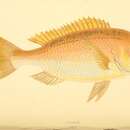Diagnostic Description
provided by FAO species catalogs
Body oval, rather deep and compressed. Head profile smoothly rounded in adults but almost straight in young; a slight frontal hump in very large individuals; eye small, suborbital space wide. Cheeks scaly; scales also present on preopercle except at its posterior margin. Mouth low, slightly oblique. Several rows of canine-like teeth, outer row by far the strongest with 4 to 6 very well developed anterior teeth in each jaw. Gillrakers on first arch 9 or 10 lower and 8 or 9 upper. Dorsal fin with 11 spines and 11 or 12 soft rays, the spines increassing in length from the first to the fouth or fifth and subequal thereafter. Anal fin with 3 spines and 7 to 9 soft rays. Scales along lateral line 62 to 68. Colour in the young specimens greyish, spotted with black on back and upper sides, becoming pink with sexual maturity; old individuals are bluish grey and the dark spots become more or less diffuse with age. Some individuals have a yellow tinge behind the mouth and on the gill cover.
Distribution
provided by FAO species catalogs
Mediterranean, most common south of 40° N (Spain, North Africa); Black Sea (very rare). Atlantic from Bay of Biscay to Cape Blanc and Madeira, exceptionally to British Isles. Elsewhere, southward to Senegal.
Size
provided by FAO species catalogs
Maximum 100 cm; common to 50 cm
Brief Summary
provided by FAO species catalogs
Benthopelagic (demersal behaviour).Inshore waters on rocky bottoms to 200 m, more common between 15 and 50 m. Young gregarious, the oldest solitary. Reproduction May (Mediterranean); gonochoric, some specimens hermaphroditic Carnivorous, young panktonophagous, adults eating fish, crustaceans and cephalopods.
Benefits
provided by FAO species catalogs
Caught with bottom trawls, lines, traps (young) and sometimes trammel nets. Flesh highly esteemed. Marketed fesh or frozen; also used for fishmeal and oil.

